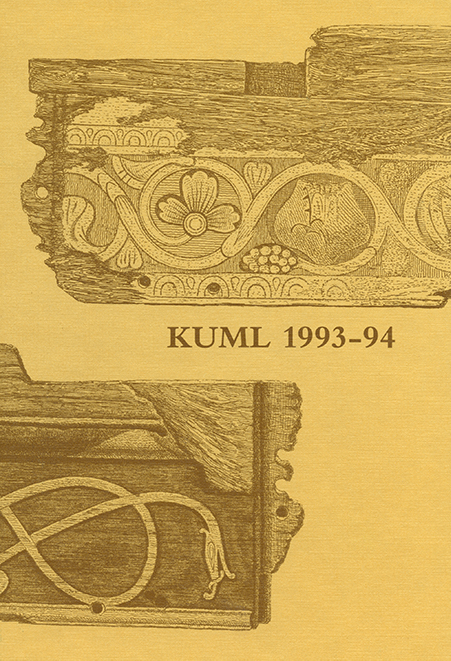Store Tyrrestrup. A large Early Bronze Age farmstead with bronze hoard
DOI:
https://doi.org/10.7146/kuml.v39i39.111963Keywords:
storre tyrrestrup, early bronze age, farmstead, bronze hoard, palstaves, north jutlandAbstract
Store Tyrrestrup
A large Early Bronze Age farmstead with bronze hoard
Eight bronzes were handed in to Vendsyssel Historical Museum in 1988. They had been found in different years on a farm named Store Tyrrrestrup, all in the same few square meters of ploughsoil. The site lies in the eastern part of Vendsyssel, northern Jutland (1) (fig. 1). The museum investigation brought three further bronze objects to light by metal detector. The eleven bronzes were two socketed axes, seven palstaves, an ingot, and a piece of melted bronze (fig. 5). Probably they were a closed deposit from the Early Bronze Age.
The effort to find the original location of the hoard led to the excavation of a large E-W orientated long house with two rows of roofbearing posts (2) (fig. 2-3). The dimensions of the building were 9x48 m, and it had two phases of construction, first being the 33 m long western part and the second the 15 m eastwards extension. The building had straight sides and rounded ends. The western part was divided into two rooms by a partition wall. There had been 12 pairs of roof-bearing posts. The average diameter of both these and also the wall posts was ca. 25 cm, but the holes for the roof-bearing posts were in average 10 cm deeper. The substantial thickness of the wall posts may mean that the walls carried some of the weight of the roof. The distance between them was 1.50-1. 75 m, which suggests a wall of bulwark construction. The hearth was situated in the western end of the building.
The substantial amount of charcoal in the postholes shows that the house had burned down. The charcoal was identified as oak, so probably the house was built of oak timber. In the eastern extension of the building there were no signs of repairs or replacements, so this part had probably only been in use for a short time when the conflagration occurred. The construction of the Store Tyrrestrup building does not differ from that of other contemporary houses in Denmark, but it was much larger (fig. 4). Scattered discoveries made in the postholes were calcined bone fragments, pottery, a sherd from a mould, flint flakes, a flint core, charcoal, and burnt pieces of clay. Also 20 carbonized cereal grains and seeds were found -4 barley, 12 emmer, 2 indeterminate cereal, 1 convolvulus and 1 buttercup (3). Taken together the finds indicate a normal domestic economy in the house. The fragment of mould is noteworthy as it shows that bronze casting actually took place at the building.
The total weight of the 11 objects in the hoard was 3.2 kg. The nine axes were of types common in N and NW Europe, and in principle they could have been made anywhere in that region. Five of the palstaves, two of which had been cast in the same mould (fig. 6), are miscastings. The two socketed axes and one of the palstaves is heat-broken (4). The ingot, the weight of which is 252.8 g, could have been intended for casting a palstave, as the average weight of these was 260 g. Analysis showed that one of the palstaves contained 94.49% copper, 5.43% tin, and 0.08% arsenic (5). There is no doubt that the eleven bronzes belonged together and were a metalworker's stock-intrade. They were all found in the ploughsoil near the house's hearth, and had probably originally been hidden somewhere in the west end of the building. Together with the mould fragment they support the possibility that the objects in the board were made locally.
C-14 datings of charcoal place the house in the middle of the Early Bronze Age, ca. 1400 years B.C. calibrated (Tauber 1990, 233). This agrees with the dating of the hoard, which can be placed typologically in the middle of the Early Bronze Age.
The hoard must have amounted to a considerable capital, and the house, which from its great size must have belonged to a wealthy and powerful man, together leave no doubt in our minds that the owner of the house was an important person. Perhaps he was one of the area's few bronze founders, and these may have been wealthy and powerful because of their mastery of the difficult art of bronze casting; but he may equally well have been a member of the landowning class and temporarily had a bronze founder in his service. There are strong arguments that the few very large buildings known from the Early Bronze Age, which stand apart from the ordinary houses of the period, reflect the same class difference as can be seen in contemporary grave finds.
Torben Nilsson
Downloads
Published
How to Cite
Issue
Section
License
Fra og med årgang 2022 er artikler udgivet i Kuml med en licens fra Creative Commons (CC BY-NC-SA 4.0).
Alle tidligere årgange af tidsskriftet er ikke udgivet med en licens fra Creative Commons.


